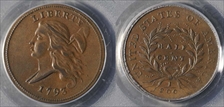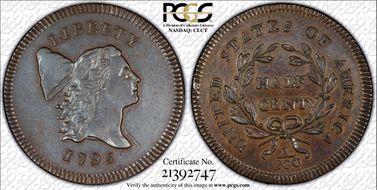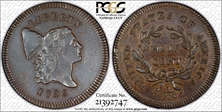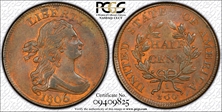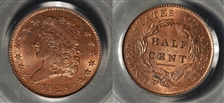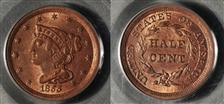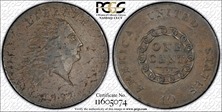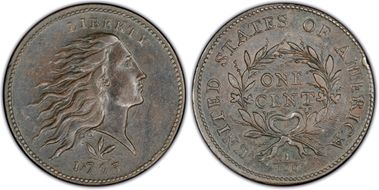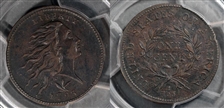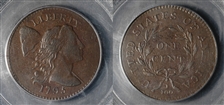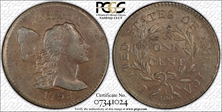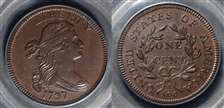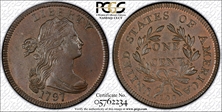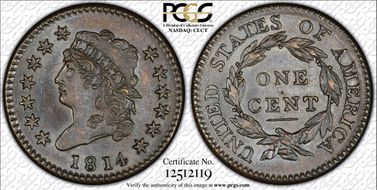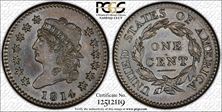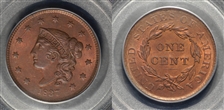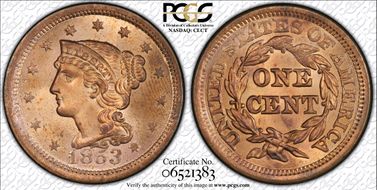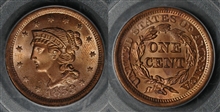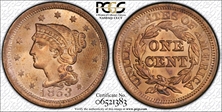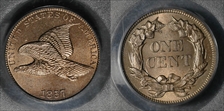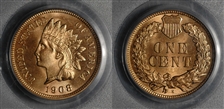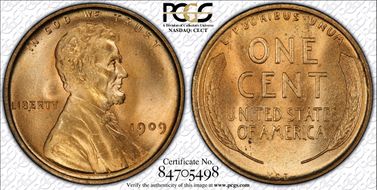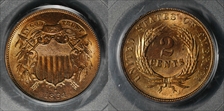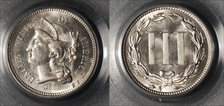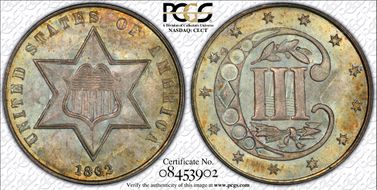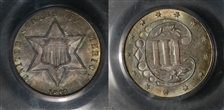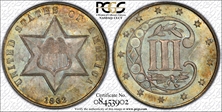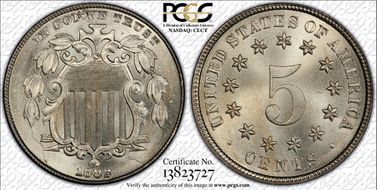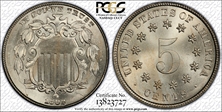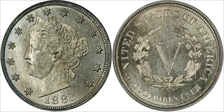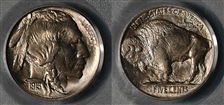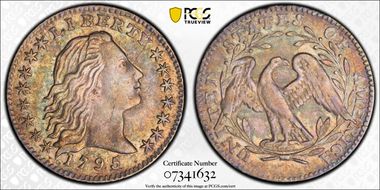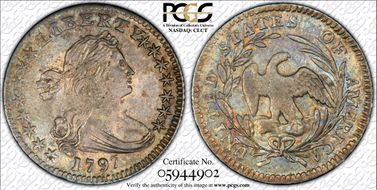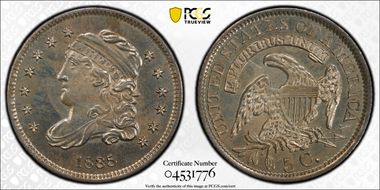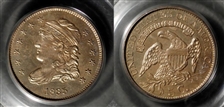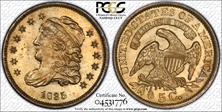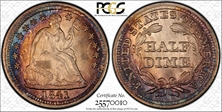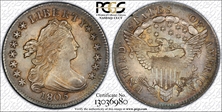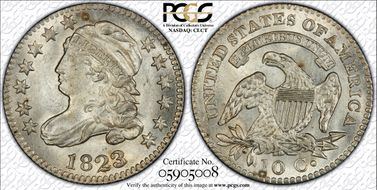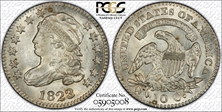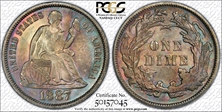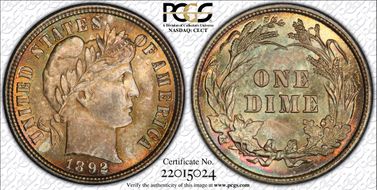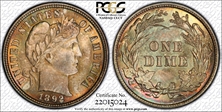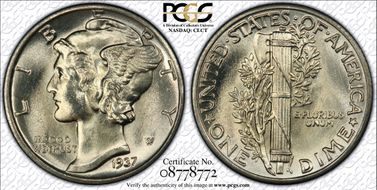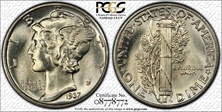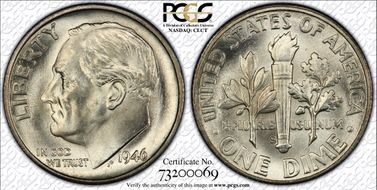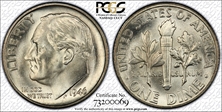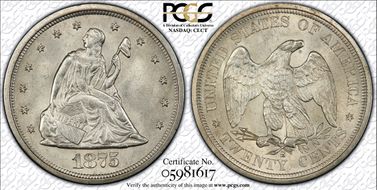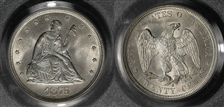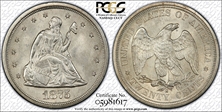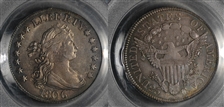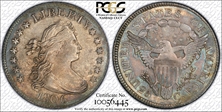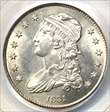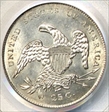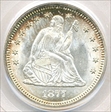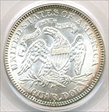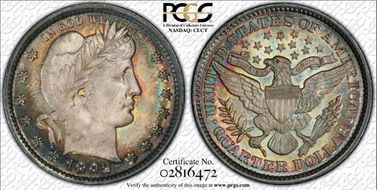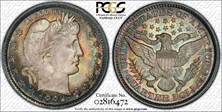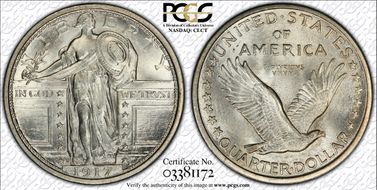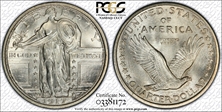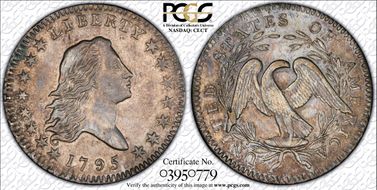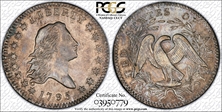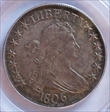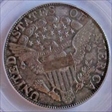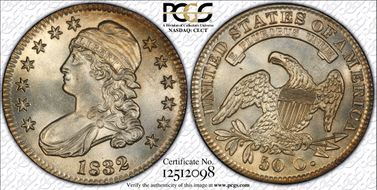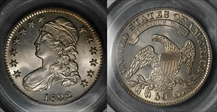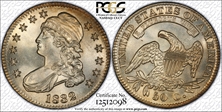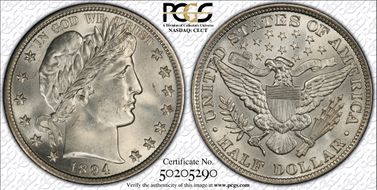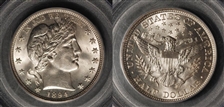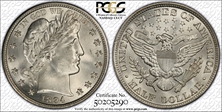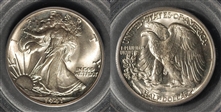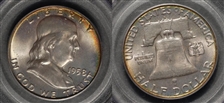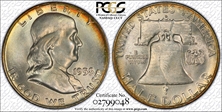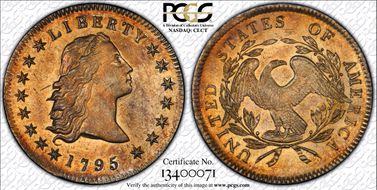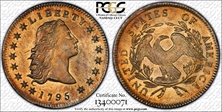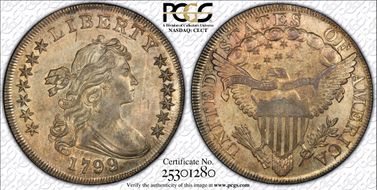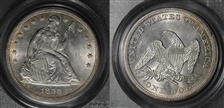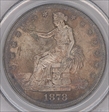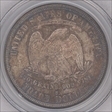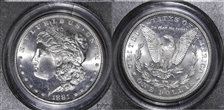Gobrecht's Raisinet Collection 的钱币相册
C-4, B-4, Low R.3. EAC 50, PQ! Manley Die State 2.0, with the die defect atop the 7. This wonderful example of this first year issue has nearly ideal color over smooth, blemish-free surfaces with well-defined, full flowing hair. It's an impressively sharp and smooth representative of this popular single-year type. Chocolate-brown dominates both sides, with a glimpse of deeper brown toning present on the lower left obverse and central reverse. Liberty's cheek and forehead display a hint of friction, but the designs are exquisitely impressed aside from minor softness on some of the letters in AMERICA. Marks are minor for the grade, and the only identifiers are two faint, superficial marks behind the cap, and two blemishes of similar small size below and between AM of AMERICA. These are inconspicuous because of subsequent natural toning, and the quality and beauty of the piece remains irrefutable. Thomas Jefferson made the half cent the lowest denomination in the 1784 “Notes on Coinage” that he submitted to the federal government. Eventually, after much delay and Congressional inaction, Jefferson's proposal emerged as the Mint Act of April 2, 1792. David Rittenhouse, Adam Eckfeldt, and Robert Birch combined to execute the design of the small copper coin with Birch and Joseph Wright engraving the dies. By May 1793 over 30,000 copper half cent planchets had been prepared and on July 20 the Philadelphia Mint coined its first 7,000 specimens. Mint employees produced a further 24,934 pieces on July 26 and the final 3,400 examples on September 18. Having delivered a total of 35,344 1793 half cents, the Mint closed on the latter date so that its staff could flee Philadelphia and its annual yellow fever epidemic.
1795 1/2 C Lettered Edge AU55 C-1, B-1, R.2. Toned a medium to dark brown in color and quite even. The strike is sharp throughout, quite an event as so many of the 1795 half cents come with poorly struck devices. Excellent surfaces are the rule, and this piece is a delight to study. There is a very faint scratch down Liberty's face below her eye, and for identification purposes a tiny planchet flake resides above the post of the E in STATES. A very scarce coin in this relatively lofty grade, with a high quality planchet and good overall eye appeal. From The Melrose Bay Collection
1795 1/2 C Lettered Edge AU55 C-1, B-1, R.2. Toned a medium to dark brown in color and quite even. The strike is sharp throughout, quite an event as so many of the 1795 half cents come with poorly struck devices. Excellent surfaces are the rule, and this piece is a delight to study. There is a very faint scratch down Liberty's face below her eye, and for identification purposes a tiny planchet flake resides above the post of the E in STATES. A very scarce coin in this relatively lofty grade, with a high quality planchet and good overall eye appeal. From The Melrose Bay Collection
1806 1/2 C Large 6, Stems MS63RB B-4, C-4, R.1. Immediately distinguishable by a large, repunched 6 with the peak affixed to the base of Liberty's bust. Much faded mint-red color remains all over the coin. Most Uncirculated representatives of this variety trace back to the hoard of 1806 B-4 Half Cents that the Chapman brothers dispersed in 1906.
1806 1/2 C Large 6, Stems MS63RB B-4, C-4, R.1. Immediately distinguishable by a large, repunched 6 with the peak affixed to the base of Liberty's bust. Much faded mint-red color remains all over the coin. Most Uncirculated representatives of this variety trace back to the hoard of 1806 B-4 Half Cents that the Chapman brothers dispersed in 1906.
1828 1/2 C 13 Stars MS64 Red. C-3, B-2, R.1. This variety is attributed by: the low 2 in the date, repunching on star 7, the second S in STATES essentially even with the tip of the highest leaf, a defect that joins the left top of H in HALF to the above leaf, and a wreath spine that extends from the leaf point above HA. Orange mint luster enlivens well preserved surfaces, and a crisp strike has emboldened the design elements. A pleasing near-Gem half cent, housed in a green-label holder. Population: 6 in 64 Red, 1 finer (2/07). EAC 63. From The Temecula Collection, Part Two.
A gorgeous fire-red near Gem type coin that has nearly mark-free surfaces. The devices are very well struck, although portions of the dentils are softly brought up. Carbon is microscopic.
1793 Chain 1C AMERICA AU53. S-3, B-4, Low R.3. EAC 40. Surfaces: The obverse surface has countless minute defects that appear to be almost entirely planchet flaws, representing an improperly refined strip of copper, a common problem in the first year of Mint operations. Sheet copper was not yet available from England, so available copper was scrap copper from local sources that Henry Voigt acquired. In his Encyclopedia of Large Cents, Breen discussed the problems with this locally available copper: "Scrap copper varied greatly in homogeneity, density, malleability, and hardness. This is partly from different trace elements and partly from the way the individual lumps had been treated in manufacture. This was a most unsatisfactory expedient; the coiner's department learned quickly that different ingots cast from it varied greatly , with far too many gas bubbles. Strip rolled from these ingots came out with too many cavities and laminations. Many surviving Chain cents accordingly show such flaws." The sophisticated collector will appreciate the planchet flaws as part of this coin's history and charm. A few tiny rim bumps are visible, and these appear to be the only post-strike imperfections. In direct opposition to the obverse, the reverse surface is nearly flawless. Only a few minute defects, rim flaws, and abrasions can be seen. Both sides have lovely medium brown color with traces of darker steel color on the high points. Considerable original mint frost remains, with splashes of lighter tan on the reverse, faded from original mint red. This example is a later die state. The obverse has prominent clash marks around and below the bust, and the reverse is flowlined with field roughening below UNITED STATES. The latest known die state of this variety, called Die State III in Breen's classification, displays heavy clash marks along Liberty's lips, chin, neck, and bust line. Breen suggested that these obverse clash marks, as seen somewhat on this example, were responsible for the "Liberty in chains epithet" sometimes given to the Chain cents. The Chain design was intended to show strength or unity of our new nation. Instead, the device was interpreted by many as representing slavery. Most of the mintage was lost or destroyed, so survivors are of various grades, usually lower quality. Porous or corroded pieces are frequently encountered. There is no question among specialists that Sheldon-3 is the most common Chain cent. Current rarity ratings for the Chain cent varieties suggest that the total surviving population of all varieties is 900 to 1,000 coins, with 400 to 500 examples of the S-3 and about 500 to 600 of all other varieties combined. Working under the assumption that the current rarity ratings are reasonably accurate, we can surmise that the original mintage occurred in about the same proportion. Approximately 18,000 examples of this die marriage were coined, with another 18,000 of the other three Sheldon numbers.
S-9, B-12, R.2. Noyes VF20; tied for CC-21. EAC VF25. PQ–. Variety: Horizontal stem parallel to the date. The bow is large and rounded. The obverse appears on S-8, S-9, and NC-4. The reverse appears on S-9. Vine and Bars Edge. The S-9 is the single most common Wreath cent variety by a wide margin. Surfaces: An attractive piece with smooth, hard, glossy surfaces. Both sides have mottled golden-brown and deep steel color. A few minor handling marks are visible on the obverse, with a small reverse edge bump over the M. Light corrosion is evident, primarily on the reverse. Full obverse and reverse borders are visible, with the reverse imperfectly centered. Both sides are sharply detailed, and the obverse and reverse types stand boldly against the field. Die State VII: The reverse has die cracks through R and CA of AMERICA, and from the left stem through UNIT. A late die state, although most of the individual die defects Breen describes are faintly visible. Census: Perhaps 10 examples are known in Mint State. This piece has considerable sharpness but is downgraded for various minor imperfections. Commentary: The S-9 is clearly the most common Wreath cent variety, and the only 1793 large cent of any design with a rarity rating less than R.3. Sheldon mentioned in Early American Cents that S.H. Chapman considered this variety to represent 35% of all existing Wreath cents. From a mintage of 63,353 Wreath cents, this would imply a "mintage" of about 22,000 coins. Raw material for copper coinage at the new Mint came from a variety of local sources, none particularly ideal, generally consisting of scrap, rough ingots, or sheet. In Breen's Large Cent Encyclopedia, contributor Craig Sholley wrote: "The locally obtained scrap proved to be especially troublesome. Copper is a difficult metal to properly melt and it is far more difficult to roll than silver or gold. The Mint, lacking both experience and proper equipment, was not prepared for either of these operations." The first of the two processes required that Mint personnel melt the metal and pour it into ingot molds, while watching for retained gas bubbles or impurities. Bubbles in the metal resulted in split planchets, laminations, or other defects to the finished coins. Impurities resulted in various streaks or discoloration spots. The other process was rolling the ingots into planchet strip of the appropriate width and thickness. The Mint used horsepower-operated rollers that were apparently poorly made. Coinage of the Wreath cents was suspended after the April 19 delivery while the rollers were repaired.
S-9, B-12, R.2. Noyes VF20; tied for CC-21. EAC VF25. PQ–. Variety: Horizontal stem parallel to the date. The bow is large and rounded. The obverse appears on S-8, S-9, and NC-4. The reverse appears on S-9. Vine and Bars Edge. The S-9 is the single most common Wreath cent variety by a wide margin. Surfaces: An attractive piece with smooth, hard, glossy surfaces. Both sides have mottled golden-brown and deep steel color. A few minor handling marks are visible on the obverse, with a small reverse edge bump over the M. Light corrosion is evident, primarily on the reverse. Full obverse and reverse borders are visible, with the reverse imperfectly centered. Both sides are sharply detailed, and the obverse and reverse types stand boldly against the field. Die State VII: The reverse has die cracks through R and CA of AMERICA, and from the left stem through UNIT. A late die state, although most of the individual die defects Breen describes are faintly visible. Census: Perhaps 10 examples are known in Mint State. This piece has considerable sharpness but is downgraded for various minor imperfections. Commentary: The S-9 is clearly the most common Wreath cent variety, and the only 1793 large cent of any design with a rarity rating less than R.3. Sheldon mentioned in Early American Cents that S.H. Chapman considered this variety to represent 35% of all existing Wreath cents. From a mintage of 63,353 Wreath cents, this would imply a "mintage" of about 22,000 coins. Raw material for copper coinage at the new Mint came from a variety of local sources, none particularly ideal, generally consisting of scrap, rough ingots, or sheet. In Breen's Large Cent Encyclopedia, contributor Craig Sholley wrote: "The locally obtained scrap proved to be especially troublesome. Copper is a difficult metal to properly melt and it is far more difficult to roll than silver or gold. The Mint, lacking both experience and proper equipment, was not prepared for either of these operations." The first of the two processes required that Mint personnel melt the metal and pour it into ingot molds, while watching for retained gas bubbles or impurities. Bubbles in the metal resulted in split planchets, laminations, or other defects to the finished coins. Impurities resulted in various streaks or discoloration spots. The other process was rolling the ingots into planchet strip of the appropriate width and thickness. The Mint used horsepower-operated rollers that were apparently poorly made. Coinage of the Wreath cents was suspended after the April 19 delivery while the rollers were repaired.
1795 1C Plain Edge AU58 S-78, B-8, R.1. This is one of the most common of all Liberty Cap large cent varieties and an ideal candidate for the date or type collector. For this die pairing, the peak of the 5 in the date just touches the bust truncation. Date and LIBERTY are closely spaced. ONE CENT is centered in the wreath and widely separated. ONE CENT is high in the wreath, as the engraver avoided placing CENT within the narrow space between the lower leaves, and the E in STATES is entered high. Specialists of 1795 cents know that the two most common varieties are S-76b and S-78, both Plain Edge varieties. The Lettered Edge varieties are significantly scarcer, as indicated by Guide Book prices. While none of the three collectible Plain Edge 1795 cent die pairs can be considered more than scarce, the type is more in-demand than the supply can handle, especially for better conditions such as Choice AU.
1795 1C Plain Edge AU58 S-78, B-8, R.1. This is one of the most common of all Liberty Cap large cent varieties and an ideal candidate for the date or type collector. For this die pairing, the peak of the 5 in the date just touches the bust truncation. Date and LIBERTY are closely spaced. ONE CENT is centered in the wreath and widely separated. ONE CENT is high in the wreath, as the engraver avoided placing CENT within the narrow space between the lower leaves, and the E in STATES is entered high. Specialists of 1795 cents know that the two most common varieties are S-76b and S-78, both Plain Edge varieties. The Lettered Edge varieties are significantly scarcer, as indicated by Guide Book prices. While none of the three collectible Plain Edge 1795 cent die pairs can be considered more than scarce, the type is more in-demand than the supply can handle, especially for better conditions such as Choice AU.
1795 1C Plain Edge AU58 S-78, B-8, R.1. This is one of the most common of all Liberty Cap large cent varieties and an ideal candidate for the date or type collector. For this die pairing, the peak of the 5 in the date just touches the bust truncation. Date and LIBERTY are closely spaced. ONE CENT is centered in the wreath and widely separated. ONE CENT is high in the wreath, as the engraver avoided placing CENT within the narrow space between the lower leaves, and the E in STATES is entered high. Specialists of 1795 cents know that the two most common varieties are S-76b and S-78, both Plain Edge varieties. The Lettered Edge varieties are significantly scarcer, as indicated by Guide Book prices. While none of the three collectible Plain Edge 1795 cent die pairs can be considered more than scarce, the type is more in-demand than the supply can handle, especially for better conditions such as Choice AU.
1797 1C Reverse of 1797, Stems, S-123, B-12, R.4 MS64BN. This coin probably traces its origin back to the Nichols find, which included many Mint State examples of this scarce variety. Sheldon-123 is one of three varieties (the other two are S-119 and S-135) made collectible in Uncirculated grades due to the Nichols Find. However, a glance at third party populations confirms that quality examples are rare by the standards of most U.S. series. This is the second of the three varieties attributed to the Nichols Find, with an extremely close date, six berries in each branch, and the final 0 high. The obverse appears on S-122, S-123, NC-2, and NC-3. The reverse appears on 1796 S-119 and 1797 S-123. There is a tiny cut (die chip) on Liberty's cheek below the eye--a diagnostic feature of this S-123--which identifies this Nichols Find variety, which is usually found in or near Mint State grades. At least 10 examples of this variety are known in Mint State, and many more just miss that level, usually with full Mint State sharpness and minor deductions for slight imperfections. Considered R.4, meaning between 80 and 200 examples survive, well over half of the known examples grade AU or better. In fact, the variety would probably be a solid R.5 or perhaps even R.6 if that hoard never existed. Like nearly all coins from the Nichols Find, the surfaces of both sides are a pleasing medium brown with slightly reflective fields. This exceptionally well struck, orange-brown example has unusually smooth surfaces and excellent eye appeal.
1797 1C Reverse of 1797, Stems, S-123, B-12, R.4 MS64BN. This coin probably traces its origin back to the Nichols find, which included many Mint State examples of this scarce variety. Sheldon-123 is one of three varieties (the other two are S-119 and S-135) made collectible in Uncirculated grades due to the Nichols Find. However, a glance at third party populations confirms that quality examples are rare by the standards of most U.S. series. This is the second of the three varieties attributed to the Nichols Find, with an extremely close date, six berries in each branch, and the final 0 high. The obverse appears on S-122, S-123, NC-2, and NC-3. The reverse appears on 1796 S-119 and 1797 S-123. There is a tiny cut (die chip) on Liberty's cheek below the eye--a diagnostic feature of this S-123--which identifies this Nichols Find variety, which is usually found in or near Mint State grades. At least 10 examples of this variety are known in Mint State, and many more just miss that level, usually with full Mint State sharpness and minor deductions for slight imperfections. Considered R.4, meaning between 80 and 200 examples survive, well over half of the known examples grade AU or better. In fact, the variety would probably be a solid R.5 or perhaps even R.6 if that hoard never existed. Like nearly all coins from the Nichols Find, the surfaces of both sides are a pleasing medium brown with slightly reflective fields. This exceptionally well struck, orange-brown example has unusually smooth surfaces and excellent eye appeal.
1797 1C Reverse of 1797, Stems, S-123, B-12, R.4 MS64BN. This coin probably traces its origin back to the Nichols find, which included many Mint State examples of this scarce variety. Sheldon-123 is one of three varieties (the other two are S-119 and S-135) made collectible in Uncirculated grades due to the Nichols Find. However, a glance at third party populations confirms that quality examples are rare by the standards of most U.S. series. This is the second of the three varieties attributed to the Nichols Find, with an extremely close date, six berries in each branch, and the final 0 high. The obverse appears on S-122, S-123, NC-2, and NC-3. The reverse appears on 1796 S-119 and 1797 S-123. There is a tiny cut (die chip) on Liberty's cheek below the eye--a diagnostic feature of this S-123--which identifies this Nichols Find variety, which is usually found in or near Mint State grades. At least 10 examples of this variety are known in Mint State, and many more just miss that level, usually with full Mint State sharpness and minor deductions for slight imperfections. Considered R.4, meaning between 80 and 200 examples survive, well over half of the known examples grade AU or better. In fact, the variety would probably be a solid R.5 or perhaps even R.6 if that hoard never existed. Like nearly all coins from the Nichols Find, the surfaces of both sides are a pleasing medium brown with slightly reflective fields. This exceptionally well struck, orange-brown example has unusually smooth surfaces and excellent eye appeal.
1814 1C Crosslet 4 MS63BN S-294, B-1, R.1. Only two die marriages are known for 1814 Cents, and each receives a separate Guide Book listing due to a different logotype on the 4. Traces of faded red color surround the legends and stars, while the fields and portrait exhibit steel-brown color. This well struck Large Cent has a nearly undisturbed obverse, and the reverse is also refreshingly clean. This is a relatively common Classic cent, but always of great importance to type collectors, as these pieces become scarce in XF and better grades.
1814 1C Crosslet 4 MS63BN S-294, B-1, R.1. Only two die marriages are known for 1814 Cents, and each receives a separate Guide Book listing due to a different logotype on the 4. Traces of faded red color surround the legends and stars, while the fields and portrait exhibit steel-brown color. This well struck Large Cent has a nearly undisturbed obverse, and the reverse is also refreshingly clean. This is a relatively common Classic cent, but always of great importance to type collectors, as these pieces become scarce in XF and better grades.
1837 1C Medium Letters MS65RB. N-6, Low R.2. The 3 in the date is low, and the left foot of the N in ONE is recut. An interesting example from a year in which the cent was the only copper denomination coined, this Gem cent has considerable original orange mint color.
1853 MS65RD. So firey red the coin almost looks like it was minted yesterday, with virtually no marks and only a slight partial fingerprint to justify this grade, as opposed to a higher one.
1853 MS65RD. So firey red the coin almost looks like it was minted yesterday, with virtually no marks and only a slight partial fingerprint to justify this grade, as opposed to a higher one.
1853 MS65RD. So firey red the coin almost looks like it was minted yesterday, with virtually no marks and only a slight partial fingerprint to justify this grade, as opposed to a higher one.
1857 Flying Eagle Cent, graded MS-65. Simply outstanding! This coin has a full strike and breathtaking eye appeal. It is a gem in every respect. The color is an even light nickel color with just a light contact marks above the Eagle's left wing. The reverse is nearly mark free. A superb coin. Pop 166; 15 finer in 66. Ex:The "Chiro" Collection. Eagle Eye Photo Seal.
1908-S 1C MS66RD. This is an outstanding, intensely bright example of the first minor (copper) coinage issue struck at a branch mint in the United States. Judging from the population data, the 1908-S and 1909-S Indian cents are about equal in rarity in high grades with full red color, and both are much, much rarer than the 1909-S VDB cent in such condition. Although the 1908-S was probably saved to some degree as the first mintmarked cent, the 1909-S Indian was saved as the last of the series (and the general collecting public saved many more 'SVDBs as a novel new design). The San Francisco cents of 1908 and 1909 were struck on lighter-colored planchets than earlier cent issues. The '08-S is a scarce (1.1 million pieces produced), semi-key issue in the Indian Head cent series at all levels of preservation. Obviously set aside shortly after delivery, this fully Red, carbon-free example of this introductory, branch-mint Indian cent displays unbelievable flash. The coin possesses full mint luster and even, orange-red coloration. Copper-gold luster adorns both sides, and the well-executed, virtually full strike is exacting throughout, resulting in crisp definition of the design features, including sharpness on the bowknot, all four diamonds, and on the tips of the feathers at the top of the Indian's headdress. Both sides are exceptionally smooth with a shimmering satin texture. Close examination reveals remarkably clean surfaces and no spots worthy of note; There are only a couple of slight, relatively unobtrusive contact marks on the cheek and neck to justify this grade, as opposed to a higher one. A magnificent example of this scarce, late-date Indian cent, this piece shows even, bright mint red color, unlike the streaky coins often seen on 1908 and especially 1909 cents. Rick Snow states "Full feathers are extremely rare" [on an '08-S] but if the strike atop the headdress feathers of this coin is not fully razor-sharp, in light of the issue's striking weakness being ever-present, this is forgivable. The Eliasberg catalog notes that 1908-S cents were struck on silver presses. The hardness of bronze compared to silver might help explain why this issue is usually found softly struck. That being said, Mr. Eliasberg held out for a sharp one, and I've been fortunate, too. The srike on this piece is exemplary. It would be difficult to imagine a more attractive example.
1864 2C Large Motto MS65RD. A fiery, very premium quality Gem of this important and widely collected odd denomination. Millions were struck of this first year issue, but full red Gems are anything but common. The surfaces of this coin display a vibrant and totally original orange-red color that barely shows just a whisper mellowing in the nearly 15 decades since its Civil War era origin. The mint red color is virtually undiminished by the passage of time, appearing today much as it did in 1864, the year Colonel Chivington massacred the Southern Cheyenne at Sand Creek. This unusual denomination was created to help fill the yawning gap in circulating coinage that resulted from the widespread hoarding of coins in the early 1860s. An historic issue designed by James Barton Longacre that is indelibly linked with the Civil War, the 1864 two cent piece is also the first U.S. coin to bear the motto IN GOD WE TRUST. The present example is the second and more commorn of the two varieties produced this year. The earlier Small Motto coins were prototypes and modified after only a few thousand were struck, with the motto enlarged on subsequent strikings. Far fewer of the Small Motto coins are seen today with full red color than of their Large Motto counterparts. Held back from an even higher grade only by light, scattered flyspecks, and uncommonly attractive even for the MS65 grade, this Large Motto Gem shows nearly full mint-red color. Both sides are intensely lustrous, with vivid crimson-orange color. All features show pinpoint striking definition, with with good detail to the highpoints. The lustrous and unabraded surfaces have no obtrusive contact marks, and only negligible carbon.
1868 3CN MS66. Well struck and untoned, with lustrous pearl-gray surfaces that are essentially unmarked on both sides. A splendid Premium Gem example of this conditionally scarce issue. Population: 25 in 66, 1 finer (2/07).(
1862/1 3CS MS66. The left half of the 2 in the date has a faint but nearly complete 1. The underdigit is faint but clearly discernible with a magnifier. Bold die clash marks are evident on this scarce overdate variety, especially on most of the obverse shield within the III. Very sharply struck for a Type Three, this piece shows exceptionally pronounced evidence of die clashing, and that is saying a lot for a three cent silver as they are usually die clashed.
1862/1 3CS MS66. The left half of the 2 in the date has a faint but nearly complete 1. The underdigit is faint but clearly discernible with a magnifier. Bold die clash marks are evident on this scarce overdate variety, especially on most of the obverse shield within the III. Very sharply struck for a Type Three, this piece shows exceptionally pronounced evidence of die clashing, and that is saying a lot for a three cent silver as they are usually die clashed.
1862/1 3CS MS66. The left half of the 2 in the date has a faint but nearly complete 1. The underdigit is faint but clearly discernible with a magnifier. Bold die clash marks are evident on this scarce overdate variety, especially on most of the obverse shield within the III. Very sharply struck for a Type Three, this piece shows exceptionally pronounced evidence of die clashing, and that is saying a lot for a three cent silver as they are usually die clashed.
1882 5C MS66. Blazing luster is the hallmark of this exceptional, untoned Premium Gem. Spindly die cracks are noticeable on the obverse, as usual. A planchet flaw is observed on the upper obverse border, between D and W. Surface blemishes are nearly nonexistent. Population: 68 in 66, 4 finer (7/07).
1882 5C MS66. Blazing luster is the hallmark of this exceptional, untoned Premium Gem. Spindly die cracks are noticeable on the obverse, as usual. A planchet flaw is observed on the upper obverse border, between D and W. Surface blemishes are nearly nonexistent. Population: 68 in 66, 4 finer (7/07).
1883 No Cents MS66. Undoubtedly one of the most common type coins in all of U. S. numismatics, the 1883 No Cents nickel is easily located in all uncirculated grades, up to and including MS66. While it may be accurate to call the No Cents nickel a "common" coin, it is not often available and considering its status as a one-year type, it certainly is not overpriced in grades above MS65.
1913 5C Type 1, MS67. The 1913 Type One Buffalo nickel is always in great demand as a first-year-of-issue date and a one-year type coin. David Lange (2000) writes that: "The changeover to the Type 2 reverse was ordered on May 6, [1913] and coinage of the revised nickels commenced four days later." The present coin is a high-end example of this popular one-year type, strongly lustrous beneath pleasing gold and iridescent toning. Sharply struck and showing the rugged detail that makes the variety so prized, even LIBERTY and the obverse rim portray relatively nice detail, these features usually showing weakness on this issue. Each side has a pronounced matte-like texture, typical of all Type One nickels (David Lange, The Complete Guide to Buffalo Nickels). Noted sculptor James E. Fraser designed the Buffalo nickel. The first type, issued only in 1913, featured a textured field and a raised mound beneath the bison. Since the mound allowed the denomination to wear, it was recessed for the Type Two design, issued later in 1913. But the Mint neglected to recess the Indian's shoulder, where the date is, and well-circulated examples of either type are often dateless. This piece displays powder blue and light gold toning over vibrant luster, which combines with the finely granular surfaces to give each side a shimmering quality. The fields of all Type One Buffalo nickels, not just the proof coins, show the textured fields as on James Earle Fraser's original models, and therefore they give the coins' luster a "shimmering quality, particularly on unworn dies," according to Lange. In fact, "first strikes from unworn dies are easily mistaken for proofs and vice versa."
Lots of detail for VF25, Old Green Holder, R.4 PQ A large question surrounding this coin is whether or not President Washington supplied the silver. Research by Joel Orosz and Carl Herkowitz published in the 2003 Amer. Journal of Numismatics cited a memorandum by John A. McAllister, Jr. who related his interview with Chief Coiner Adam Eckfeldt: "In conversation with Mr. Adam Eckfeldt (Apr. 9, 1844) at the Mint, he informed me that the Half Dismes...were struck, expressly for Gen. Washington, to the extent of One Hundred Dollars, which sum he deposited in Bullion or Coin, for the purpose. Mr. E. thinks that Gen. W. distributed them as presents. Some were sent to Europe, but the greater number, he believes, were given to friends of Gen. W. in Virginia. No more of them were ever coined." Eric von Klinger in a June 13, 2005 Coin World review of the article entitled "Document Details Half Disme: Confirms that G. Washington was Source of Silver," wrote: "General Washington did indeed deposit silver for the 1792 half dismes." Orosz responded in a July 4, 2005 letter to the editor that: "We never claim in our article that we have proved that President Washington provided the silver used to strike the half dismes, as both the headline and the first sentence of von Klinger's article flatly state. In our article, we conclude that while the great preponderance of the evidence points toward Washington as the silver provider, the pieces of evidence that could prove he was - Washington's diary for 1792 and Acting Chief Coiner Henry Voigt's July 1792 account book - are unavailable. Washington was a long-time diarist, but the press of his presidential duties prevented him from keeping a diary in 1792. Voigt did keep an account book, but it was lost about a century ago, and no one knows where it is, or if it even still exists. Therefore, while the authors believe that all of the available evidence points to Washington, we cannot prove he was the donor beyond the shadow of a doubt."
1795 H10C MS62. V-5, LM-8, R.3. The years 1795 and 1796 were busy and productive ones for the fledgling U.S. Mint. Director Henry DeSaussure--continuing his dual missions to produce circulating gold coinage and to improve the design of circulating silver coinage--employed the noted portraitist Gilbert Stuart in the summer of 1795 to fashion a new portrait of Liberty to replace the unpopular Flowing Hair design on silver denominations. From those sketches, artist John Eckstein prepared obverse device punches, and Chief Engraver Robert Scot prepared dies conforming to the Mint Act of 1792. The new Draped Bust, Small Eagle design was introduced first in 1795 on the silver dollar. Although no 1795 half dimes with the Draped Bust motif were coined, a 1795-dated obverse die of the new design was produced. The recorded mintage of 86,416 half dimes included both 1794- and 1795-dated pieces, but about three times as many 1795 pieces have been certified. The mintage of 1795 half dimes was divided into 10 different die marriages, most of them quite scarce. This coin is a representative of the scarce LM-8 variety. It is identifiable by the position of star 1 between curls 1 and 2 on the obverse and the wreath with no berries under the left wing of the eagle on the reverse. The LM-8 variety is one of the more available marriages, and is a popular choice with early type collectors. The number of high quality LM-8 half dimes is explained by its presence in a hoard mentioned by Walter Breen in his Proof Encyclopedia of more than 100 Mint State Flowing Hair half dimes, of this and two other varieties, discovered in the 1870s and dispersed by William Elliot Woodward around 1880, known as the Wadsworth-Rea hoard. On this variety there are seven curls, the first star points between curls 2 and 3, and the reverse shows the berries arranged 3-4 with none beneath the wings. There is no berry inside or outside of the U in UNITED, and a spike protrudes from the wreath and points between the first T and A of STATES. The bold diagnostic obverse die crack extends from the upper rim to Y in LIBERTY to the nose and then across the neck to the top of the 7 in the date. This variety is most easily attributed by the lack of berries around the lower left portion of the wreath and the relative position of the lowest outside left leaf relative to the U in UNITED. The die crack through the Y in LIBERTY also confirms this die pairing. The present example is sharper than most and centered, normally not seen on most early Bust design half dimes. No adjustment marks are apparent on either side of this coin.
1795 H10C MS62. V-5, LM-8, R.3. The years 1795 and 1796 were busy and productive ones for the fledgling U.S. Mint. Director Henry DeSaussure--continuing his dual missions to produce circulating gold coinage and to improve the design of circulating silver coinage--employed the noted portraitist Gilbert Stuart in the summer of 1795 to fashion a new portrait of Liberty to replace the unpopular Flowing Hair design on silver denominations. From those sketches, artist John Eckstein prepared obverse device punches, and Chief Engraver Robert Scot prepared dies conforming to the Mint Act of 1792. The new Draped Bust, Small Eagle design was introduced first in 1795 on the silver dollar. Although no 1795 half dimes with the Draped Bust motif were coined, a 1795-dated obverse die of the new design was produced. The recorded mintage of 86,416 half dimes included both 1794- and 1795-dated pieces, but about three times as many 1795 pieces have been certified. The mintage of 1795 half dimes was divided into 10 different die marriages, most of them quite scarce. This coin is a representative of the scarce LM-8 variety. It is identifiable by the position of star 1 between curls 1 and 2 on the obverse and the wreath with no berries under the left wing of the eagle on the reverse. The LM-8 variety is one of the more available marriages, and is a popular choice with early type collectors. The number of high quality LM-8 half dimes is explained by its presence in a hoard mentioned by Walter Breen in his Proof Encyclopedia of more than 100 Mint State Flowing Hair half dimes, of this and two other varieties, discovered in the 1870s and dispersed by William Elliot Woodward around 1880, known as the Wadsworth-Rea hoard. On this variety there are seven curls, the first star points between curls 2 and 3, and the reverse shows the berries arranged 3-4 with none beneath the wings. There is no berry inside or outside of the U in UNITED, and a spike protrudes from the wreath and points between the first T and A of STATES. The bold diagnostic obverse die crack extends from the upper rim to Y in LIBERTY to the nose and then across the neck to the top of the 7 in the date. This variety is most easily attributed by the lack of berries around the lower left portion of the wreath and the relative position of the lowest outside left leaf relative to the U in UNITED. The die crack through the Y in LIBERTY also confirms this die pairing. The present example is sharper than most and centered, normally not seen on most early Bust design half dimes. No adjustment marks are apparent on either side of this coin.
LM-1, V-2, R.3. PQ. Not a trace of wear can be found on this impressive Mint State example, despite blunt central obverse and reverse details. The strike of this piece is typical of nearly every example, and is a direct result of opposing design motifs on the obverse and reverse dies. The eagle on the reverse represents the deepest portion of that die, and it is directly opposite the center of Liberty on the obverse, and these two features competed for metal flow when the coin was struck. Note that the portions of either die that are opposite the blank fields on the opposite side have extremely sharp definition. The surfaces of this piece have satiny luster with reflective fields beneath lovely gray-gold and iridescent toning.
LM-1, V-2, R.3. PQ. Not a trace of wear can be found on this impressive Mint State example, despite blunt central obverse and reverse details. The strike of this piece is typical of nearly every example, and is a direct result of opposing design motifs on the obverse and reverse dies. The eagle on the reverse represents the deepest portion of that die, and it is directly opposite the center of Liberty on the obverse, and these two features competed for metal flow when the coin was struck. Note that the portions of either die that are opposite the blank fields on the opposite side have extremely sharp definition. The surfaces of this piece have satiny luster with reflective fields beneath lovely gray-gold and iridescent toning.
1835 H10C Small Date, Large 5C MS65. V-5, LM-8.2, R.2. Sun-gold toning is predominant, and the strike is excellent. The 1 in the date is high, and the tip of the feather is right of center of the 5 in the denomination. This late die state of this die marriage is more plentiful than the early die state.
1835 H10C Small Date, Large 5C MS65. V-5, LM-8.2, R.2. Sun-gold toning is predominant, and the strike is excellent. The 1 in the date is high, and the tip of the feather is right of center of the 5 in the denomination. This late die state of this die marriage is more plentiful than the early die state.
1835 H10C Small Date, Large 5C MS65. V-5, LM-8.2, R.2. Sun-gold toning is predominant, and the strike is excellent. The 1 in the date is high, and the tip of the feather is right of center of the 5 in the denomination. This late die state of this die marriage is more plentiful than the early die state.
1841 H10C MS67 V-2 Mintage: 50,000. The last 1 in the date is low and recut, and a small lunule appears between stars 10 and 11. Sharply struck, this is an extraordinarily well-preserved Superb Gem of this type, with full original luster and an exemplary strike, struck from moderately clashed dies. The surfaces emit a warm glow, with lightly toned, golden-rose centers and rich golden-brown, mauve and cobalt-blue peripheral colors about the rims. This second year of the Drapery sub-type is more available than its introductory 1840 counterpart, but relatively few pieces have been certified by PCGS in Mint State grades. Among half dime collectors the 1841 is considered a common date, but it certainly is uncommon in MS67 condition. VARIETIES: V-1 (Proof only). V-2 and V-3 represent variations of the date replacement. There is also a repunched date (RPD) variety with a repunched 1 at the top, and a reverse with heavy lettering designated V-4. The V-2 in late die states exhibits a significant die crack running diagonally from 2 to 7 o’clock. Evidencing not a hint of a crack, this piece would seem to be an example of a much earlier die state. The V-2 variety usually is strongly struck, other than minor weakness of dentils on the reverse, with a full head, shield and toe. The date and stars are boldly punched. The pendant lines up just right of the upright of the 4, and the shield points to the top of the 1.
1841 H10C MS67 V-2 Mintage: 50,000. The last 1 in the date is low and recut, and a small lunule appears between stars 10 and 11. Sharply struck, this is an extraordinarily well-preserved Superb Gem of this type, with full original luster and an exemplary strike, struck from moderately clashed dies. The surfaces emit a warm glow, with lightly toned, golden-rose centers and rich golden-brown, mauve and cobalt-blue peripheral colors about the rims. This second year of the Drapery sub-type is more available than its introductory 1840 counterpart, but relatively few pieces have been certified by PCGS in Mint State grades. Among half dime collectors the 1841 is considered a common date, but it certainly is uncommon in MS67 condition. VARIETIES: V-1 (Proof only). V-2 and V-3 represent variations of the date replacement. There is also a repunched date (RPD) variety with a repunched 1 at the top, and a reverse with heavy lettering designated V-4. The V-2 in late die states exhibits a significant die crack running diagonally from 2 to 7 o’clock. Evidencing not a hint of a crack, this piece would seem to be an example of a much earlier die state. The V-2 variety usually is strongly struck, other than minor weakness of dentils on the reverse, with a full head, shield and toe. The date and stars are boldly punched. The pendant lines up just right of the upright of the 4, and the shield points to the top of the 1.
1805 10C 4 Berries MS63 JR-2, R.2. The die crack through ERTY and star 8 and the eponymous reverse identify this instantly as an example of the JR-2 4 Berries, and this is a lovely example for the grade. While JR-2 is the more plentiful of the two known die marriages of the 1805 Draped Bust Dime, examples that have survived the passage of time with fully Mint State surfaces must be considered rare. The dimes of 1805 are known only by two die marriages that share a common obverse, with a small spine protruding from the top of the 5 in the date. The reverses show four or five olives on the olive branch clutched by the Heraldic Eagle, or berries as they are usually called, with the present 4 Berries reverse having narrow A's and leaves that are clear of the peripheral lettering. This coin shows appealing medium-gray and golden highlights on each side, with few relevant abrasions. The 1805 4 Berries will never be an uncommon die pairing, but both the 4 Berries and 5 Berries JR-1 are popular Guide Book varieties eagerly sought by collectors, and both are fairly available for a price into the lower Mint State grades. However, Select Uncirculated pieces are scarce and are sought after by both type collectors and Early Dime specialists. The 1805 JR-2 dime is the second most common Draped Bust variety behind the 1807, and both coins are ideal for collectors who want a single example of the draped bust, heraldic eagle design in type set collections. Obverse Die: The 1 nearly touches the lowest curl and the top of the 5 has a spine extending into the bust. LIB are close and BERTY are wide. Star 1 is far from the curl, star 7 is farther from L, star 8 is very close to the Y, and star 13 is close to the bust. State a. Perfect with no crack through ERTY. State b. Cracked from the rim through ERTY. Minor clash marks. State c. Cracked from the rim below star 13 into the bottom of the bust. The die is lapped, removing most of the clash marks. State d. Cracked from the rim between stars 9 and 10 into the bust, about one-third of the distance down from the base of the neck to the bottom of the bust. Reverse Die: Four berries in the branch. All letters in the legend are separated from each other and from the devices. AMER are extremely close together, with AM slightly higher than ER. The star pattern is unusual with two rows of six stars each, and a single star touching the back of the eagle's neck. Stars 1, 2, and 5, touch the clouds above. State a. Perfect. State b Minor die rust near D of UNITED.
1805 10C 4 Berries MS63 JR-2, R.2. The die crack through ERTY and star 8 and the eponymous reverse identify this instantly as an example of the JR-2 4 Berries, and this is a lovely example for the grade. While JR-2 is the more plentiful of the two known die marriages of the 1805 Draped Bust Dime, examples that have survived the passage of time with fully Mint State surfaces must be considered rare. The dimes of 1805 are known only by two die marriages that share a common obverse, with a small spine protruding from the top of the 5 in the date. The reverses show four or five olives on the olive branch clutched by the Heraldic Eagle, or berries as they are usually called, with the present 4 Berries reverse having narrow A's and leaves that are clear of the peripheral lettering. This coin shows appealing medium-gray and golden highlights on each side, with few relevant abrasions. The 1805 4 Berries will never be an uncommon die pairing, but both the 4 Berries and 5 Berries JR-1 are popular Guide Book varieties eagerly sought by collectors, and both are fairly available for a price into the lower Mint State grades. However, Select Uncirculated pieces are scarce and are sought after by both type collectors and Early Dime specialists. The 1805 JR-2 dime is the second most common Draped Bust variety behind the 1807, and both coins are ideal for collectors who want a single example of the draped bust, heraldic eagle design in type set collections. Obverse Die: The 1 nearly touches the lowest curl and the top of the 5 has a spine extending into the bust. LIB are close and BERTY are wide. Star 1 is far from the curl, star 7 is farther from L, star 8 is very close to the Y, and star 13 is close to the bust. State a. Perfect with no crack through ERTY. State b. Cracked from the rim through ERTY. Minor clash marks. State c. Cracked from the rim below star 13 into the bottom of the bust. The die is lapped, removing most of the clash marks. State d. Cracked from the rim between stars 9 and 10 into the bust, about one-third of the distance down from the base of the neck to the bottom of the bust. Reverse Die: Four berries in the branch. All letters in the legend are separated from each other and from the devices. AMER are extremely close together, with AM slightly higher than ER. The star pattern is unusual with two rows of six stars each, and a single star touching the back of the eagle's neck. Stars 1, 2, and 5, touch the clouds above. State a. Perfect. State b Minor die rust near D of UNITED.
1823/2 10C Large Es MS64 JR-3, R.2. A fairly common variety and the most common 1823 Dime - all being overdates. The overdate feature is clear with a loupe, as the base of the 2 extends to the right of the 3, and the neck of the 2 is visible within the lower loop of the 3. Diagnostically, the D in UNITED is over a previously punched E, obverse star 7 points to the upper edge of Liberty's headband (not at her upper curl, as it does in the JR-2), and the E in STATES is higher than the second S. There is a prominent center dot directly beneath Liberty's ear. Intensely lustrous, both sides shimmer with a fully original, satin-white texture. There are blushes of pale-apricot tinting here and there around the obverse periphery, but the overall appearance is one of radiant brilliance. Well struck throughout, most areas are actually sharply impressed from the dies. Minimally abraded and nearly qualifying as an MS-65, Condition Census for both the 1832/2 JR-3 die marriage as well as the Large Es. This variety is scarce as a near-Gem, and just one piece is ranked higher, at MS65, by PCGS (10/07).
1823/2 10C Large Es MS64 JR-3, R.2. A fairly common variety and the most common 1823 Dime - all being overdates. The overdate feature is clear with a loupe, as the base of the 2 extends to the right of the 3, and the neck of the 2 is visible within the lower loop of the 3. Diagnostically, the D in UNITED is over a previously punched E, obverse star 7 points to the upper edge of Liberty's headband (not at her upper curl, as it does in the JR-2), and the E in STATES is higher than the second S. There is a prominent center dot directly beneath Liberty's ear. Intensely lustrous, both sides shimmer with a fully original, satin-white texture. There are blushes of pale-apricot tinting here and there around the obverse periphery, but the overall appearance is one of radiant brilliance. Well struck throughout, most areas are actually sharply impressed from the dies. Minimally abraded and nearly qualifying as an MS-65, Condition Census for both the 1832/2 JR-3 die marriage as well as the Large Es. This variety is scarce as a near-Gem, and just one piece is ranked higher, at MS65, by PCGS (10/07).
1887 10C MS66. Cobalt-blue, gray, and lavender toning dances over lustrous surfaces. Well struck, except for the hair on Liberty's head and the bow knot. No major blemishes are apparent.
1887 10C MS66. Cobalt-blue, gray, and lavender toning dances over lustrous surfaces. Well struck, except for the hair on Liberty's head and the bow knot. No major blemishes are apparent.
An impressive Premium Gem, this lovely first-year Barber dime has bold and complete design elements. It is an original coin that is toned in deep iridescent shadings, well balanced on each side, with excellent underlying mint luster.
An impressive Premium Gem, this lovely first-year Barber dime has bold and complete design elements. It is an original coin that is toned in deep iridescent shadings, well balanced on each side, with excellent underlying mint luster.
1937 10C MS67FB. Adolph A. Weinman's Winged Liberty head or "Mercury" design made its debut as part of the coinage revolution that swept the dime, quarter, and half dollar in 1916. This classic design was used on the dime, and the obverse depicted a portrait of Liberty modeled after Elsie Stevens. Liberty wears a winged cap which symbolizes freedom of thought, but she was soon confused with the Roman god Mercury, and the name has been with her ever since. A fasces with an olive sprig dominates the reverse. Production quality was consistently excellent on this 1937 issue of more than 56 million pieces, so it is not surprising that many Superb Full Bands examples survive today. But even for an issue that is known for high quality survivors, this Superb Gem is as well preserved as one would expect from the grade, offering thick mint frost in generous proportions on each side, along with a bold strike and a near-total lack of contact evidence. Glowing luster radiates from the near-pristine, snow-white surfaces. The dazzling, untoned surfaces are strongly detailed and look almost as they did when made. Sharply struck, the all-important central bands are well defined. The only contact mark is a tiny nick in the field on the reverse, above and to the right of the O in ONE.
1937 10C MS67FB. Adolph A. Weinman's Winged Liberty head or "Mercury" design made its debut as part of the coinage revolution that swept the dime, quarter, and half dollar in 1916. This classic design was used on the dime, and the obverse depicted a portrait of Liberty modeled after Elsie Stevens. Liberty wears a winged cap which symbolizes freedom of thought, but she was soon confused with the Roman god Mercury, and the name has been with her ever since. A fasces with an olive sprig dominates the reverse. Production quality was consistently excellent on this 1937 issue of more than 56 million pieces, so it is not surprising that many Superb Full Bands examples survive today. But even for an issue that is known for high quality survivors, this Superb Gem is as well preserved as one would expect from the grade, offering thick mint frost in generous proportions on each side, along with a bold strike and a near-total lack of contact evidence. Glowing luster radiates from the near-pristine, snow-white surfaces. The dazzling, untoned surfaces are strongly detailed and look almost as they did when made. Sharply struck, the all-important central bands are well defined. The only contact mark is a tiny nick in the field on the reverse, above and to the right of the O in ONE.
1946-S 10C MS67. A highly lustrous example from the first year of issue, precisely struck and highly attractive. Roosevelt dime collectors know that the early S-mint dates are the most desirable issues in the series.
1946-S 10C MS67. A highly lustrous example from the first year of issue, precisely struck and highly attractive. Roosevelt dime collectors know that the early S-mint dates are the most desirable issues in the series.
1806 25C MS63 B-3, R.1. A satiny and refreshingly unabraded Select Mint State example of this scarce early date. Tan-brown color graces most of the obverse, bounded by blue-green toning near the rims. The reverse is equally colorful, and features areas of aqua-blue and lavender patina. Some bluntness of strike in the centers and on the right side stars, not uncommon for the Draped Bust type. The superb, talented engraver Joseph Wright, designer of the Liberty Cap cent and half cent, was the first full-time engraver hired at the Philadelphia Mint. Tragically, he died in September 1793 during one of the annual yellow fever epidemics that killed so many early Philadelphia residents. Robert Scot was hired only two months later as chief engraver, a post he held until his death in 1823. Scot was born in 1744 and was already 50 years old when he began working for the Mint. Although Scot was later criticized for his modest talent and slow work style, among his improvements at the Mint were the use of device punches; for example, the whole head of Liberty, so that only the date, stars, and letters required addition to the working dies. By 1807 Scot, then 63, faced serious competition from a younger rival, John Reich, who was much more talented judging from each man's artistic accomplishments. Breen writes in his Complete Encyclopedia: "John Reich sold himself into indentured service to escape to the USA from the Napoleonic Wars. As early as 1801 his name came to official attention as one of the finest engravers in the country. Opposition from Robert Scot prevented the Mint from hiring him except for occasional odd temporary assignments. But in 1807, Scot's health (for which read failing eyesight) was a source of serious concern to officialdom; accordingly, the Mint hired Reich as assistant engraver at a pittance of $600 per year. "Reich's first assignment was to create new designs for gold and silver denominations: an insult to Scot. The first ones to benefit from Reich's attention were the denominations most in demand at banks: half dollars and half eagles." In 1796 and 1797 only the the Draped Bust (a.k.a. Fillet Head) obverse was combined with the Small Eagle reverse, which was in turn replaced in 1801 by the Heraldic Eagle reverse, an imitation of the Great Seal of the United States. Both designs are attributed to Robert Scot. In 1807, the last year of the Draped Bust quarter design, Reich joined the Mint as assistant engraver and the half dollar designs were modified yet again, this time to the familiar and ubiquitous Capped Bust or Turban Head design. Liberty now faced left and wore the Martha Washington-style "mob cap" on her head. The reverse features a more naturalistic eagle, although it bears a small shield attached to the center of its breast. The quarter was considered a less important denomination and didn't resume production until 1815, eventually also adopting the Capped Bust design.
1806 25C MS63 B-3, R.1. A satiny and refreshingly unabraded Select Mint State example of this scarce early date. Tan-brown color graces most of the obverse, bounded by blue-green toning near the rims. The reverse is equally colorful, and features areas of aqua-blue and lavender patina. Some bluntness of strike in the centers and on the right side stars, not uncommon for the Draped Bust type. The superb, talented engraver Joseph Wright, designer of the Liberty Cap cent and half cent, was the first full-time engraver hired at the Philadelphia Mint. Tragically, he died in September 1793 during one of the annual yellow fever epidemics that killed so many early Philadelphia residents. Robert Scot was hired only two months later as chief engraver, a post he held until his death in 1823. Scot was born in 1744 and was already 50 years old when he began working for the Mint. Although Scot was later criticized for his modest talent and slow work style, among his improvements at the Mint were the use of device punches; for example, the whole head of Liberty, so that only the date, stars, and letters required addition to the working dies. By 1807 Scot, then 63, faced serious competition from a younger rival, John Reich, who was much more talented judging from each man's artistic accomplishments. Breen writes in his Complete Encyclopedia: "John Reich sold himself into indentured service to escape to the USA from the Napoleonic Wars. As early as 1801 his name came to official attention as one of the finest engravers in the country. Opposition from Robert Scot prevented the Mint from hiring him except for occasional odd temporary assignments. But in 1807, Scot's health (for which read failing eyesight) was a source of serious concern to officialdom; accordingly, the Mint hired Reich as assistant engraver at a pittance of $600 per year. "Reich's first assignment was to create new designs for gold and silver denominations: an insult to Scot. The first ones to benefit from Reich's attention were the denominations most in demand at banks: half dollars and half eagles." In 1796 and 1797 only the the Draped Bust (a.k.a. Fillet Head) obverse was combined with the Small Eagle reverse, which was in turn replaced in 1801 by the Heraldic Eagle reverse, an imitation of the Great Seal of the United States. Both designs are attributed to Robert Scot. In 1807, the last year of the Draped Bust quarter design, Reich joined the Mint as assistant engraver and the half dollar designs were modified yet again, this time to the familiar and ubiquitous Capped Bust or Turban Head design. Liberty now faced left and wore the Martha Washington-style "mob cap" on her head. The reverse features a more naturalistic eagle, although it bears a small shield attached to the center of its breast. The quarter was considered a less important denomination and didn't resume production until 1815, eventually also adopting the Capped Bust design.
1806 25C MS63 B-3, R.1. A satiny and refreshingly unabraded Select Mint State example of this scarce early date. Tan-brown color graces most of the obverse, bounded by blue-green toning near the rims. The reverse is equally colorful, and features areas of aqua-blue and lavender patina. Some bluntness of strike in the centers and on the right side stars, not uncommon for the Draped Bust type. The superb, talented engraver Joseph Wright, designer of the Liberty Cap cent and half cent, was the first full-time engraver hired at the Philadelphia Mint. Tragically, he died in September 1793 during one of the annual yellow fever epidemics that killed so many early Philadelphia residents. Robert Scot was hired only two months later as chief engraver, a post he held until his death in 1823. Scot was born in 1744 and was already 50 years old when he began working for the Mint. Although Scot was later criticized for his modest talent and slow work style, among his improvements at the Mint were the use of device punches; for example, the whole head of Liberty, so that only the date, stars, and letters required addition to the working dies. By 1807 Scot, then 63, faced serious competition from a younger rival, John Reich, who was much more talented judging from each man's artistic accomplishments. Breen writes in his Complete Encyclopedia: "John Reich sold himself into indentured service to escape to the USA from the Napoleonic Wars. As early as 1801 his name came to official attention as one of the finest engravers in the country. Opposition from Robert Scot prevented the Mint from hiring him except for occasional odd temporary assignments. But in 1807, Scot's health (for which read failing eyesight) was a source of serious concern to officialdom; accordingly, the Mint hired Reich as assistant engraver at a pittance of $600 per year. "Reich's first assignment was to create new designs for gold and silver denominations: an insult to Scot. The first ones to benefit from Reich's attention were the denominations most in demand at banks: half dollars and half eagles." In 1796 and 1797 only the the Draped Bust (a.k.a. Fillet Head) obverse was combined with the Small Eagle reverse, which was in turn replaced in 1801 by the Heraldic Eagle reverse, an imitation of the Great Seal of the United States. Both designs are attributed to Robert Scot. In 1807, the last year of the Draped Bust quarter design, Reich joined the Mint as assistant engraver and the half dollar designs were modified yet again, this time to the familiar and ubiquitous Capped Bust or Turban Head design. Liberty now faced left and wore the Martha Washington-style "mob cap" on her head. The reverse features a more naturalistic eagle, although it bears a small shield attached to the center of its breast. The quarter was considered a less important denomination and didn't resume production until 1815, eventually also adopting the Capped Bust design.
1831 25C Small Letters MS64. B-4, R.1. Minage: 398,000. No quarters were struck in 1829 or 1830, and when the denomination resumed production in 1831, the diameter was reduced from 27 mm to 24.3 mm. The weight and alloy were unchanged, which implies that the new quarters were thicker. Half eagles also were reduced in diameter, beginning in 1829, but otherwise retained prior alloy and weight standards. These changes in diameter were made to conform to the new close collar technology introduced to the Philadelphia Mint. However, Capped Bust halves, which then dominated silver coin production, continued to be struck with lettered edges until the 1836 Reeded Edge halves were produced. This is a lustrous and brilliant silver-white example of the Capped Bust quarter dollar design. Star 7 points to lower curl, the lower right star is close to the hair, square based 2 in the denomination, eagle has long tongue, 25 C closer to eagle than dentils, 25 is high and the arrow heads are thin. There are remnants of die rust above and left of the final S in STATES. This is a later die state of the B-4 variety with a fine die crack through the C of the denomination to the stem above, and another connecting the lower left base of the A in AMERICA with the middle serif of F in OF. Repunching shows on the 5 of the denomination. This is Die State III in Walter Breen's revision of the Browning reference, apparently the most common die state of this variety. Only the barest glimpse of a golden patina accompanies this needle-sharp near-Gem. The strike is exquisite and a strong lens reveals only trivial contact. A wonderful type coin from the Age of Jackson from The Lanterman's Mill Collection.
1831 25C Small Letters MS64. B-4, R.1. Minage: 398,000. No quarters were struck in 1829 or 1830, and when the denomination resumed production in 1831, the diameter was reduced from 27 mm to 24.3 mm. The weight and alloy were unchanged, which implies that the new quarters were thicker. Half eagles also were reduced in diameter, beginning in 1829, but otherwise retained prior alloy and weight standards. These changes in diameter were made to conform to the new close collar technology introduced to the Philadelphia Mint. However, Capped Bust halves, which then dominated silver coin production, continued to be struck with lettered edges until the 1836 Reeded Edge halves were produced. This is a lustrous and brilliant silver-white example of the Capped Bust quarter dollar design. Star 7 points to lower curl, the lower right star is close to the hair, square based 2 in the denomination, eagle has long tongue, 25 C closer to eagle than dentils, 25 is high and the arrow heads are thin. There are remnants of die rust above and left of the final S in STATES. This is a later die state of the B-4 variety with a fine die crack through the C of the denomination to the stem above, and another connecting the lower left base of the A in AMERICA with the middle serif of F in OF. Repunching shows on the 5 of the denomination. This is Die State III in Walter Breen's revision of the Browning reference, apparently the most common die state of this variety. Only the barest glimpse of a golden patina accompanies this needle-sharp near-Gem. The strike is exquisite and a strong lens reveals only trivial contact. A wonderful type coin from the Age of Jackson from The Lanterman's Mill Collection.
1877 25C MS66. Type Two Reverse. The 1877 Seated Liberty quarter is more difficult to locate than the mintage of nearly 11 million pieces would suggest. Many examples were melted in 1878 to provide silver bullion for Morgan dollars. The present coin is a well-struck Premium Gem, with lustrous surfaces and gold and violet highlights. The reverse displays extensive die cracks and clash marks.
1877 25C MS66. Type Two Reverse. The 1877 Seated Liberty quarter is more difficult to locate than the mintage of nearly 11 million pieces would suggest. Many examples were melted in 1878 to provide silver bullion for Morgan dollars. The present coin is a well-struck Premium Gem, with lustrous surfaces and gold and violet highlights. The reverse displays extensive die cracks and clash marks.
1892 25C MS66. Mintage: 8,237,245. An impressive Gem with warm golden gray centers that give way to intense gold, violet, crimson, carmine, and other vibrant hues too numerous to mention. Sharply struck from a Type II reverse die with the eagle's right wing covering all but the serif of the E in UNITED. The difference between Type I and Type II quarters can be easily remembered by the mnemonic device "Now you see it, now you don't." On Type Ones, the middle serif of the E in UNITED is about halfway visible, while on Type Two quarters, the eagle's wing covers it.
1892 25C MS66. Mintage: 8,237,245. An impressive Gem with warm golden gray centers that give way to intense gold, violet, crimson, carmine, and other vibrant hues too numerous to mention. Sharply struck from a Type II reverse die with the eagle's right wing covering all but the serif of the E in UNITED. The difference between Type I and Type II quarters can be easily remembered by the mnemonic device "Now you see it, now you don't." On Type Ones, the middle serif of the E in UNITED is about halfway visible, while on Type Two quarters, the eagle's wing covers it.
1917-D 25C Type 1 MS66 Full Head, Mintage: 1,509,200. Hermon Atkins MacNeil's Standing Liberty is one of the most beautiful designs ever to grace a U.S. quarter. The issues of 1916 and the first half of 1917 display Liberty with an exposed breast. For years, collectors have accepted Breen's story that the Society for the Suppression of Vice forced the modification of the original Standing Liberty quarter design on grounds of obscenity. While the society certainly voiced its opinion and exercised its political muscle, Treasury Secretary William G. McAdoo was the real driving force behind the introduction of the Type Two design in 1917. Fearing public criticism, McAdoo ordered the design change to preserve his own political ambitions. His presidential aspirations were, however, dashed in the elections of 1918 and 1924. The present coin is a brilliant, frosty example of one of the beautiful, underrated and short-lived Type-One-mintmarked Standing Liberty quarters. The D-mint 1917 Type One quarter sells for approximately twice as much as its P-mint counterpart, yet it is three to five times scarcer. The 1917-D Type One is not a rare coin in an absolute sense but, being a branch mint issue, is it not surprising that examples are a bit more elusive than those of the 1917 Type One production. This disparity widens as one progresses up the grading scale. Although not as common as its P-mint counterpart, the 1917-D Type One is still a popular issue for Gem quality type purposes. Once the early troubles were worked out with the modest number of pieces struck in 1916, the Type One design yielded consistently excellent strikes. As with many high grade survivors, pinpoint detailing embodies all the design elements of the present example of this first-year Denver issue. This is an uncommonly well-defined coin for the series, going beyond full definition of Liberty's head and gown lines. Fully struck on all the design features, the detail is superb not only of Liberty's head and gown, but there is also unusually sharp definition of the small feathers on the eagle's breast, and on the ear, neck, and throat of Liberty. There is a sharp line separating the hair, and the horizontal and vertical shield lines are fully brought up as well. Extremely appealing with intense mint luster and no mentionable distractions of any sort, the silver-white untoned surfaces display a characteristic matte-like texture, although with greater radiance than is normally seen. This is a truly amazing Standing Liberty quarter regardless of date. The striking details are especially notable and brilliant throughout, the surfaces exude a thick mint frost that rolls around each side unimpeded by the post-striking defects one would expect on a lower graded coin.
1917-D 25C Type 1 MS66 Full Head, Mintage: 1,509,200. Hermon Atkins MacNeil's Standing Liberty is one of the most beautiful designs ever to grace a U.S. quarter. The issues of 1916 and the first half of 1917 display Liberty with an exposed breast. For years, collectors have accepted Breen's story that the Society for the Suppression of Vice forced the modification of the original Standing Liberty quarter design on grounds of obscenity. While the society certainly voiced its opinion and exercised its political muscle, Treasury Secretary William G. McAdoo was the real driving force behind the introduction of the Type Two design in 1917. Fearing public criticism, McAdoo ordered the design change to preserve his own political ambitions. His presidential aspirations were, however, dashed in the elections of 1918 and 1924. The present coin is a brilliant, frosty example of one of the beautiful, underrated and short-lived Type-One-mintmarked Standing Liberty quarters. The D-mint 1917 Type One quarter sells for approximately twice as much as its P-mint counterpart, yet it is three to five times scarcer. The 1917-D Type One is not a rare coin in an absolute sense but, being a branch mint issue, is it not surprising that examples are a bit more elusive than those of the 1917 Type One production. This disparity widens as one progresses up the grading scale. Although not as common as its P-mint counterpart, the 1917-D Type One is still a popular issue for Gem quality type purposes. Once the early troubles were worked out with the modest number of pieces struck in 1916, the Type One design yielded consistently excellent strikes. As with many high grade survivors, pinpoint detailing embodies all the design elements of the present example of this first-year Denver issue. This is an uncommonly well-defined coin for the series, going beyond full definition of Liberty's head and gown lines. Fully struck on all the design features, the detail is superb not only of Liberty's head and gown, but there is also unusually sharp definition of the small feathers on the eagle's breast, and on the ear, neck, and throat of Liberty. There is a sharp line separating the hair, and the horizontal and vertical shield lines are fully brought up as well. Extremely appealing with intense mint luster and no mentionable distractions of any sort, the silver-white untoned surfaces display a characteristic matte-like texture, although with greater radiance than is normally seen. This is a truly amazing Standing Liberty quarter regardless of date. The striking details are especially notable and brilliant throughout, the surfaces exude a thick mint frost that rolls around each side unimpeded by the post-striking defects one would expect on a lower graded coin.
1795 50C 2 Leaves AU55. O-102, R.4. This piece is an intermediate die state, the obverse meeting Overton's requirements for O-102a and the reverse perfect as an O-102. It is also one of the finest known examples of the die marriage. In the fourth edition of Overton, Don Parsley recorded the Condition Census as 55, 45, 40, 30, 30. The finest examples to appear in recent auctions (and the only AU grade coins) are an AU55 ANACS piece that Heritage sold in November 2003 and an uncertified AU50 sold by Stack's in May 2001. Each side has a few minor scuffs and abrasions, but the overall eye appeal of this example is excellent. Satiny pale gray surfaces exhibit sharp design features with nearly full luster, accented by delightful gold and iridescent toning.
1795 50C 2 Leaves AU55. O-102, R.4. This piece is an intermediate die state, the obverse meeting Overton's requirements for O-102a and the reverse perfect as an O-102. It is also one of the finest known examples of the die marriage. In the fourth edition of Overton, Don Parsley recorded the Condition Census as 55, 45, 40, 30, 30. The finest examples to appear in recent auctions (and the only AU grade coins) are an AU55 ANACS piece that Heritage sold in November 2003 and an uncertified AU50 sold by Stack's in May 2001. Each side has a few minor scuffs and abrasions, but the overall eye appeal of this example is excellent. Satiny pale gray surfaces exhibit sharp design features with nearly full luster, accented by delightful gold and iridescent toning.
1806 50C Pointed 6, Stem MS63. O-120a, R.4. A huge mintage of 839,576 Draped Bust half dollars was achieved in 1806, with 28 die varieties known for the date. A collection of 1806 die varieties and states would provide a monumental challenge. The O-120 reverse is one of those few numismatic situations where virtually every surviving coin could be considered a slightly different die state. This scarce variety is most easily identified by the die crack above the hair of Liberty on the obverse, and especially on the reverse by the broken patch on the shield, which gives the coin a special character not found on other varieties. Known as the Broken Shield variety, in its intermediate and late die states this variety is instantly recognized by (and popular for) the unusual, heavy die break, or "cud." A large piece broke out of the die right across the shield on the reverse, atop the fourth vertical stripe of the shield its earliest stages of progression. In later die states, this cud eventually extends across the shield until only the first vertical stripe is unaffected. This example is an intermediate state and is much earlier than that plated in the Parsley/Overton book. The shield die break encompasses all or part of three vertical stripes. The die break extends from pale 2 of gule 3 to a point midway between gules 5 and 6. Another break joins the left part of the first two horizontal shield stripes. Two die cracks join the border to the right ribbon end below M of AMERICA. These start at the same point on the border, with one crack following the right diagonal of the A, the other curving through M, with the area between these just beginning to sink into a retained cud. An additional crack extends through the tops of UNITE to the border over D. Many diagnostic die cracks are evident, including the crack across the tail feathers and the crack from the leaf to the base of RI. A couple light scratches in the right obverse fields serve to mark the pedigree of this piece, an intricately struck half dollar that lacks consequential abrasions. The actual design elements on each side of this lovely Draped Bust half dollar are boldly defined, within the context of the design type, with a well-centered impression and full obverse and reverse border details. The strike is crisp and full, with clear details even on the eagle's breast feathers, although a few of the upper hair details are weakly defined, as nearly always. The dusky grayish-silver colored obverse has considerable underlying mint luster, with iridescent tones of gold, pastel pink, sky blue and sea green circling the borders. The reverse has similar toning throughout and shimmering luster, swirling atop exceptional surfaces with none of the scratches mentioned for the obverse. This Select Mint State coin is a phenomenal example of this scarce variety, and one of the two or three finest known of the die state.
1806 50C Pointed 6, Stem MS63. O-120a, R.4. A huge mintage of 839,576 Draped Bust half dollars was achieved in 1806, with 28 die varieties known for the date. A collection of 1806 die varieties and states would provide a monumental challenge. The O-120 reverse is one of those few numismatic situations where virtually every surviving coin could be considered a slightly different die state. This scarce variety is most easily identified by the die crack above the hair of Liberty on the obverse, and especially on the reverse by the broken patch on the shield, which gives the coin a special character not found on other varieties. Known as the Broken Shield variety, in its intermediate and late die states this variety is instantly recognized by (and popular for) the unusual, heavy die break, or "cud." A large piece broke out of the die right across the shield on the reverse, atop the fourth vertical stripe of the shield its earliest stages of progression. In later die states, this cud eventually extends across the shield until only the first vertical stripe is unaffected. This example is an intermediate state and is much earlier than that plated in the Parsley/Overton book. The shield die break encompasses all or part of three vertical stripes. The die break extends from pale 2 of gule 3 to a point midway between gules 5 and 6. Another break joins the left part of the first two horizontal shield stripes. Two die cracks join the border to the right ribbon end below M of AMERICA. These start at the same point on the border, with one crack following the right diagonal of the A, the other curving through M, with the area between these just beginning to sink into a retained cud. An additional crack extends through the tops of UNITE to the border over D. Many diagnostic die cracks are evident, including the crack across the tail feathers and the crack from the leaf to the base of RI. A couple light scratches in the right obverse fields serve to mark the pedigree of this piece, an intricately struck half dollar that lacks consequential abrasions. The actual design elements on each side of this lovely Draped Bust half dollar are boldly defined, within the context of the design type, with a well-centered impression and full obverse and reverse border details. The strike is crisp and full, with clear details even on the eagle's breast feathers, although a few of the upper hair details are weakly defined, as nearly always. The dusky grayish-silver colored obverse has considerable underlying mint luster, with iridescent tones of gold, pastel pink, sky blue and sea green circling the borders. The reverse has similar toning throughout and shimmering luster, swirling atop exceptional surfaces with none of the scratches mentioned for the obverse. This Select Mint State coin is a phenomenal example of this scarce variety, and one of the two or three finest known of the die state.
1832 50C Small Letters MS64 PCGS. O-106, R.1. Mintage: 4,797,000. Star 1 is recut, instantly identifying this variety, and a tiny dotlike hole is seen at the lower shield vertex. The 5 in the denomination has a short, thick top. Line 1 of stripe 2 and line 2 of stripe 4 extend upward through two horizontal shield lines. The Draped Bust half dollar yielded to the perennially popular Capped Bust motif in 1807. In 1807 the Mint introduced a new half dollar design that collectors today have come to call the Turban Head or Capped Bust variety. This lovely near-Gem is highly lustrous with radiant silver-white surfaces and a bold strike. The coin is just a couple of trivial cheek abrasions away from full Gem status. Extremely high-end for the grade, and eye-appealing as well.
1832 50C Small Letters MS64 PCGS. O-106, R.1. Mintage: 4,797,000. Star 1 is recut, instantly identifying this variety, and a tiny dotlike hole is seen at the lower shield vertex. The 5 in the denomination has a short, thick top. Line 1 of stripe 2 and line 2 of stripe 4 extend upward through two horizontal shield lines. The Draped Bust half dollar yielded to the perennially popular Capped Bust motif in 1807. In 1807 the Mint introduced a new half dollar design that collectors today have come to call the Turban Head or Capped Bust variety. This lovely near-Gem is highly lustrous with radiant silver-white surfaces and a bold strike. The coin is just a couple of trivial cheek abrasions away from full Gem status. Extremely high-end for the grade, and eye-appealing as well.
1832 50C Small Letters MS64 PCGS. O-106, R.1. Mintage: 4,797,000. Star 1 is recut, instantly identifying this variety, and a tiny dotlike hole is seen at the lower shield vertex. The 5 in the denomination has a short, thick top. Line 1 of stripe 2 and line 2 of stripe 4 extend upward through two horizontal shield lines. The Draped Bust half dollar yielded to the perennially popular Capped Bust motif in 1807. In 1807 the Mint introduced a new half dollar design that collectors today have come to call the Turban Head or Capped Bust variety. This lovely near-Gem is highly lustrous with radiant silver-white surfaces and a bold strike. The coin is just a couple of trivial cheek abrasions away from full Gem status. Extremely high-end for the grade, and eye-appealing as well.
1884 50C Repunched Date, WB-102, MS66 PCGS. The motto IN GOD WE TRUST was added to the reverse of Seated Liberty coinage in 1866. Although the Civil War ended in 1865, the resumption of specie payments would have to wait for the passage of the Mint Act of February 12, 1873. As such, deliveries of half dollars from 1866-1873 remained low with the exception of a few S-mint issues. The first-year the Motto Half Dollar was produced was 1866, but only to the extent of only 745,625 pieces versus the 3.2 million pieces that were struck of the 1875-S. The P-mint Seated halves from 1879 to 1890 have tiny mintages, as series specialists can attest. This is due primarily to the millions of Morgan dollars that the Philadelphia Mint pumped out with annual celerity, mandated by the Bland-Allison Act. Mintages of Seated half dollars from 1879 to 1890 ranged from 4,400 to 12,001 business strikes per year. Of them all, the 1882 and 1884 mintages are tied for the smallest—4,400 pieces each year—as sufficient quantities of half dollars were in circulation. In effect, the paltry production makes every coin a first-strike representative, hence the larger proportion of markedly proof-like survivors. This popular issue has one of the smallest mintages in not only the Seated half dollar series, but all half dollar series from 1794 to present. Judging by the certified population data, collectors and/or the general public were certainly aware of the tiny mintages, as the numbers extant today are several times the typical surviving population. Of the 4,400 business-strike Seated Liberty half dollars struck in 1884, some of the rare high-grade examples, like the present coin, show deeply reflective proof-like fields. A spectacular gem example of this low mintage, late date Seated half, it is fully struck and the design elements are sharply detailed. The strike is razor-sharp throughout and tiny, well-concealed marks fail to distract. Originality is a hallmark of both sides. Rich toning in shades of cobalt-blue, violet, red, and golden-amber enhance the visual quality of this remarkable Premium Gem, forming a beautiful halo around untoned centers. The thickly frosted portraits of Liberty and the eagle generate significant, albeit undesignated proof-like contrast against the partly mirrored fields. The reverse fields are essentially fully proof-like. This toned, proof-like piece has high field-device contrast and only the most minor distractions. Highly reflective luster adds to the wonderful eye appeal of this superb coin, an exemplary 1884 half. Variety WB-102 with a Recut 4, struck from the business-strike die, the present coin shows minor recutting on the base of the 4. All circulation strikes show the 4 slightly recut north. A business strike-only die pairing, and one of only two, the other being the rare variant with the top of an errant 8 in the denticles beneath the 8 and 4. Provenance: Larry Whitlow
1894 50C MS65. For the connoisseur seeking a Gem quality example of this issue, consider this brilliant example. The surfaces of this Gem are nearly perfect, with soft, frosty silver luster. It is sharply struck with nearly full details on both sides. An extraordinary Gem.
1894 50C MS65. For the connoisseur seeking a Gem quality example of this issue, consider this brilliant example. The surfaces of this Gem are nearly perfect, with soft, frosty silver luster. It is sharply struck with nearly full details on both sides. An extraordinary Gem.
1894 50C MS65. For the connoisseur seeking a Gem quality example of this issue, consider this brilliant example. The surfaces of this Gem are nearly perfect, with soft, frosty silver luster. It is sharply struck with nearly full details on both sides. An extraordinary Gem.
1941 50C MS67. The entry issue into the widely collected 1941 to 1947 short set. The 1941 and 1943 are generally regarded as the best-produced coins in this short series for use as a type coin, even though the 1946-D is more available. This is an absolutely splendid example. A spectacular common date Walker, exhibiting dazzling, untoned surfaces that offer razor sharp detail and an almost total absence of noticeable blemishes. Even minuscule marks are hard to locate. While Mint State survivors of this high mintage wartime issue from the Philadelphia mint abound in today's market, few can compete with the technical merits of this Superb Gem. A simply lovely coin irrespective of date, the surfaces are fully lustrous with a bright, frosty sheen. Untoned and virtually blemish-free, both sides are fully brought up in all areas.
1958-D 50C MS66 Full Bell Lines. This was the final year that the Mint issued mint sets in cardboard holders with lots of sulphur to tone the coins. Tomaska noted: "Beautifully toned MS66 FBL and MS67 FBL 1958-D Franklins are usually among the most captivating coins in a top Franklin set. The colors are often dramatic - shimmering iridescent 'Peter Max' rainbows on the most spectacular pieces." A nearly perfect strike, practically flawless surface preservation, and attractive, slightly understated toning combine to make this Franklin half dollar an ideal type coin. One of the best preserved and prettiest mint set Franklins one of likely to set eyes on, this is a Premium Gem Franklin with likely mint set origins of this difficult late-series issue. This outstanding example is sharply detailed with a thin arc of colorful splashes of marvelous rose, orange, and lime-green iridescence captivating the viewer and enlivening both the obverse and the reverse rims. Vibrant, satiny, cartwheel mint luster illuminates the clean, colorful surfaces, and the strike is quite bold. Superbly defined, the excellent strike transcends the Full Bell Lines to include the lettering on the bell. Even among the normally well preserved mint set half dollars from this year, probably the source of this coin, only a small number of survivors could compete with the technical merits of this exceptional piece. The 1958-D Franklin Half dollar is the most available date of the series in Superb (MS67) Gem condition, because of its typically sharp strike. Still, Superb Gems with Full Bell Lines are quite rare. I'm happy with a well struck and magnificently preserved Premium (MS66) Gem that has spectacular eye appeal due to its vivid toning. A lovely specimen of this first year of the type issue.
1958-D 50C MS66 Full Bell Lines. This was the final year that the Mint issued mint sets in cardboard holders with lots of sulphur to tone the coins. Tomaska noted: "Beautifully toned MS66 FBL and MS67 FBL 1958-D Franklins are usually among the most captivating coins in a top Franklin set. The colors are often dramatic - shimmering iridescent 'Peter Max' rainbows on the most spectacular pieces." A nearly perfect strike, practically flawless surface preservation, and attractive, slightly understated toning combine to make this Franklin half dollar an ideal type coin. One of the best preserved and prettiest mint set Franklins one of likely to set eyes on, this is a Premium Gem Franklin with likely mint set origins of this difficult late-series issue. This outstanding example is sharply detailed with a thin arc of colorful splashes of marvelous rose, orange, and lime-green iridescence captivating the viewer and enlivening both the obverse and the reverse rims. Vibrant, satiny, cartwheel mint luster illuminates the clean, colorful surfaces, and the strike is quite bold. Superbly defined, the excellent strike transcends the Full Bell Lines to include the lettering on the bell. Even among the normally well preserved mint set half dollars from this year, probably the source of this coin, only a small number of survivors could compete with the technical merits of this exceptional piece. The 1958-D Franklin Half dollar is the most available date of the series in Superb (MS67) Gem condition, because of its typically sharp strike. Still, Superb Gems with Full Bell Lines are quite rare. I'm happy with a well struck and magnificently preserved Premium (MS66) Gem that has spectacular eye appeal due to its vivid toning. A lovely specimen of this first year of the type issue.
1958-D 50C MS66 Full Bell Lines. This was the final year that the Mint issued mint sets in cardboard holders with lots of sulphur to tone the coins. Tomaska noted: "Beautifully toned MS66 FBL and MS67 FBL 1958-D Franklins are usually among the most captivating coins in a top Franklin set. The colors are often dramatic - shimmering iridescent 'Peter Max' rainbows on the most spectacular pieces." A nearly perfect strike, practically flawless surface preservation, and attractive, slightly understated toning combine to make this Franklin half dollar an ideal type coin. One of the best preserved and prettiest mint set Franklins one of likely to set eyes on, this is a Premium Gem Franklin with likely mint set origins of this difficult late-series issue. This outstanding example is sharply detailed with a thin arc of colorful splashes of marvelous rose, orange, and lime-green iridescence captivating the viewer and enlivening both the obverse and the reverse rims. Vibrant, satiny, cartwheel mint luster illuminates the clean, colorful surfaces, and the strike is quite bold. Superbly defined, the excellent strike transcends the Full Bell Lines to include the lettering on the bell. Even among the normally well preserved mint set half dollars from this year, probably the source of this coin, only a small number of survivors could compete with the technical merits of this exceptional piece. The 1958-D Franklin Half dollar is the most available date of the series in Superb (MS67) Gem condition, because of its typically sharp strike. Still, Superb Gems with Full Bell Lines are quite rare. I'm happy with a well struck and magnificently preserved Premium (MS66) Gem that has spectacular eye appeal due to its vivid toning. A lovely specimen of this first year of the type issue.
B-5, BB-27. R-1. An absolutely lovely coin, the visual appeal of which easily transcends its numerical grade. Delicately varying shades of golden toning aptly accent assertively struck, fully vibrant underlying surfaces. The fields exhibit an exceptionally atypical degree of reflectivity that only further heighten a bold strike. In fact, this extraordinary luster causes the viewer to look twice in case they have somehow confused this outstanding example with a Morgan dollar! Its visual allure surpasses most mint state survivors of this type.
B-5, BB-27. R-1. An absolutely lovely coin, the visual appeal of which easily transcends its numerical grade. Delicately varying shades of golden toning aptly accent assertively struck, fully vibrant underlying surfaces. The fields exhibit an exceptionally atypical degree of reflectivity that only further heighten a bold strike. In fact, this extraordinary luster causes the viewer to look twice in case they have somehow confused this outstanding example with a Morgan dollar! Its visual allure surpasses most mint state survivors of this type.
1878-S T$1 MS64+. The 1878-S Trade dollar enjoyed a large mintage of 4.1 million pieces, and the date is readily available in most grades today. However, examples in Choice condition are scarce, and higher-grade pieces are rare. The present coin displays nice toning, with an iridescent violet and golden-brown patina, and ample frosty mint luster and sharply detailed devices.
1878-S T$1 MS64+. The 1878-S Trade dollar enjoyed a large mintage of 4.1 million pieces, and the date is readily available in most grades today. However, examples in Choice condition are scarce, and higher-grade pieces are rare. The present coin displays nice toning, with an iridescent violet and golden-brown patina, and ample frosty mint luster and sharply detailed devices.
A lustrous and virtually brilliant Premium Gem that boasts an exacting strike. A clean-cheeked and beautiful silver type coin.




















